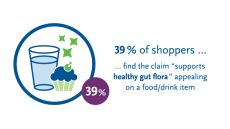Lycopene's new lease of life as functional food ingredient
looks to be opening up, since Vitatene gained novel foods approval
for its ingredient derived from the Blakeslea trispora
fungus last year.
Lycopene from tomatoes was approved for use in foods as a colouring in 1997. This has meant that the ingredient can be listed on labels as E1161D, but that companies have not been able to flag up 'contains lycopene' to draw attention to its health benefits. Lycopene has been the subject of much recent research, including its potential to reduce risk of certain cancers and heart disease. In October 2006 Vitatene was granted novel foods approval for its lycopene, which is produced by co-fermentation of two strains of the B trispora fungus. With the green light for tomato sources expected to follow, the red carotenoid is the latest addition to food-makers toolkit for formulating innovative products on a health platform. The company, a subsidiary of Spanish penicillin company Antibioticos, has until now been able to supply the ingredient in Europe only for dietary supplements. It filed for novel foods approval in October 2003. However despite the positive signs, issues remain over lycopene's use as functional ingredient. When it first came onto the market, it was regarded simply as a tomato derivative and, as such, the permitted dosage was high. Since then, however, more research into its health benefits has led lycopene to be seen as a molecule in its own right. As synthetic versions have emerged, the European Food Standards Authority (EFSA) has been prompted to evaluate the daily intake. Consequently, in three years time Vitatene must submit to the Commission data as to the groups of foods with lycopene from Blakeslea trispora that have been placed on the market in the EU and the corresponding use levels of its lycopene. For now, the conclusion is that it would lead to an additional intake of up to about 2 mg/day. Moreover EFSA is also conducting a reevaluation of colourings. It has indicated that it will not grant an opinion on Vitatene's lycopene for use as a colour in the EU, a petition lodged six months ago, until that evaluation has been concluded. While there is a chance these assessments may prove a regulatory fly in the ointment, Vitatene sales manager Luisa Volpati is positive it won't be long before other approvals in the same vein as Vitatene's are granted. For instance, in September 2004 LycoRed filed for novel foods approval to market its lycopene oleoresin from tomatoes for food products, including yoghurts, cheese, bread, sausages and cereal bars. Volpati magnanimously believes that there is a lot of space for everyone on the market. "We would like to give a future to the molecule," she told NutraIngredients.com. Lycopene is not Vitatene's core business. Rather, its main activities revolve around another carotenoid, beta carotene, also from BS. But in adding lycopene to its portfolio, the company aims to give industry an alternative. Its lycopene is very similar to tomato sourced versions, but the colour and the impurity profile may be different. Natural lycopene extraction typically involves a bioresin from whole tomato and is not a by-product, which means its production is quite expensive. But Vitatene's process requires only sugar and the raw material, in crystal form, meaning that achieves more of the ingredient at the end of the process for the volume of raw material put in. Price-wise it can be "at least as competitive as tomato, sometimes even more so". It comes from a crystal, whereas tomato-derived lycopene is from a bioresin, which means that Vitatene Vitatene's plant is located in Spain, and the non-GM raw material is sourced from within the EU. Its capacity at present is "a few metric tonnes," Volpati said, "but the potential is massive." The company would like to sell its ingredient as a formulated product, at five or ten per, according to market needs. For the time being, its main focus is on Europe.




















